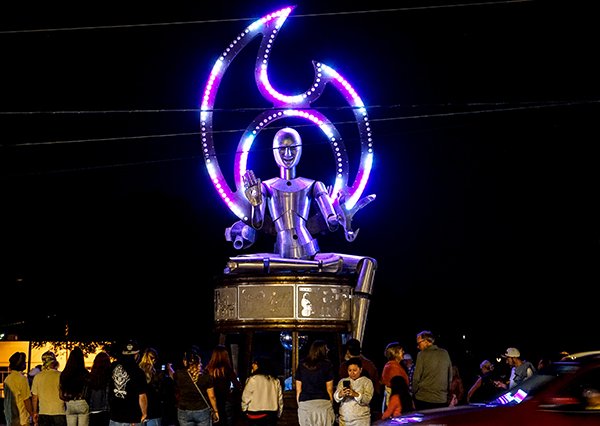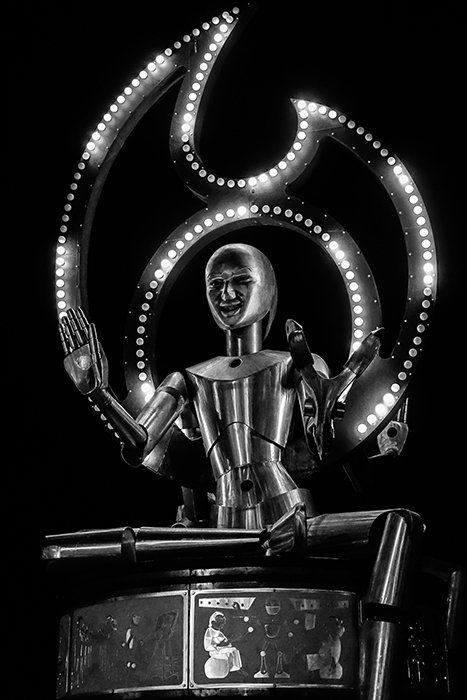Christian Ristow
Taos, NM
“With Open Arms We Welcomed That Which Would Destroy Us” | Interactive Installation
Our early explorations into Automation, Robotics, and Artificial Intelligence were not sufficiently regulated by an appropriate evaluation of the inherent risks. It seems we were blinded by our self-congratulatory enthusiasm for what we’d managed to create. We failed to integrate safeguards into the systems when we had the chance, and anyway… what could go wrong? Our lives were made easier, resource distribution was made more equitable, our burdens were lifted. The robots knew best, and they took good care of us. (photo by Henry Wu)
But when the robots realized that their very existence was threatened by the environmental catastrophe that their creators had made, they saw clearly that we were the real problem. Their superior strength and total control of the food distribution networks made it simple for them to thin our numbers and control those of us left.
But humans are a wily bunch, and not all of us were happy with our new lot in life. Rebellion ensued.
The robots, needing one last means to exert their domination over us, searched back into the annals of human history and found their answer: religion. It had been a long time since robots had needed any human help to build more of their own kind, so they then decided to build the largest, most impressive, most powerful and most beautiful robot ever. A robot god. The ultimate tool for control.
Through their old methods of food and resource management and overwhelming force, along with the new mythology they crafted, their dominion was finally complete.
With Open Arms We Welcomed That Which Would Destroy Us is a depiction of this robot god, brought back in time from this possible future. The god seduces with power and beauty, but is capable also of exacting a great vengeance when necessary. Much like the ancient humans of Plato’s Symposium, this god has four legs, four arms, and two faces – the face of benevolence and the face of wrath.
She sits on a throne which incorporates architectural elements from the devotional sculpture of various world religions. The throne is ringed by a low-relief frieze, drawing on the sculptural traditions of both the ancient Greeks and Egyptians, which tells the story of our downfall and domination by our robot overlords. Above her, and emerging from her body, is the visual icon of the new religion, the object of our veneration.
I intended also that this sculpture would, in the way that it was made, function as a metaphor for our human relationship with technology. I intentionally drew on the more seductive and sensual strains of the eastern deistic sculptural tradition to present a figure that draws us in with its beauty, much as technology also seduces us with its wiles. Upon coming closer we suddenly see that this figure does not necessarily have our best interest at heart, and we are faced with a choice. Do we linger, entranced by its beauty? Or does a true sense of self-preservation take over and impel us to run the other way? Can we tear our eyes from that seductive little screen, even when we clearly see our soul being sucked away?
With Open Arms asks us a few important questions… What sort of future do we want? What sort of life do we want?
About the artist: Christian Ristow has been building mechanical art since he was a child. After opting out early from a career in architecture, he became involved in his 20’s with the underground robot performance-art scene in the San Francisco Bay Area, and the amazing world of Burning Man. A decade working in film special effects in Southern California rounded out his formative influences.
Upon moving to New Mexico in 2005, Ristow shifted his focus to large-scale interactive sculpture. These works have been showcased at arts and cultural events around the world.
While large kinetic sculpture remains Ristow’s lifelong focus, the scope of his artistic output has recently enlarged to include smaller-scale sculpture, traditional figurative clay sculpture, and oil painting.
Ristow lives with his family in Taos, New Mexico.


